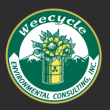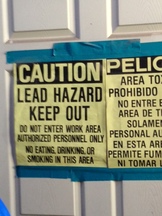Lead
|
Lead is a toxic metal that has been used for the past 2000 years in products found everywhere from the lead goblets and aqueducts in ancient Rome to the letters in Benjamin Franklin’s printing press. Lead can still be found today in; painted surfaces in our homes, children’s toys, soil, and drinking water. Lead was originally used in paint to make it last longer and look brighter. Most of the time lead paint was used on exterior surfaces, but was also used in the kitchens and bathrooms of some houses. The use of lead paint in residential properties was discontinued in 1978 and we are still dealing with its environmental impacts today.
|
Lead was also used in gasoline until 1978 and may still be found today in industrial paint mixtures used on streets, in industrial buildings and on pipes, boilers, or vehicles.
Health Concerns and Lead Poisoning
Symptoms of lead poisoning are not always obvious and are often misinterpreted by medical personnel. The only sure way to determine lead poisoning is to take a blood lead level test.
Children:
o Children under age 6 are most at risk of developing lead poisoning because they are growing rapidly and tend to put their hands and objects that could be contaminated with lead dust into their mouths. Additionally, children’s bodies absorb 50% of the lead they digest or breathe compared to 10% absorbed by adults
o According to the CDC approximately 250,000 US children aged 1-5 years have blood lead levels greater than 10 micrograms of lead per deciliter of blood (the level at which CDC recommends public health actions be initiated)
o Lead poisoning in children is associated with decreased intelligence, ADD, learning disabilities, behavioral problems, nervous system and kidney damage, and speech and language problems. High levels have been known to cause seizures, unconsciousness and in some cases, death.
o Damage to the body caused by lead poisoning is permanent.
Adults
o Main route for lead into the body is through inhalation.
o In pregnant women lead in the blood stream is transferred to the fetus potentially causing brain damage and death
o Lead poisoning in adults can cause high blood pressure, fertility problems in both men and women, digestive problems, nerve disorders, sexual disorders, memory and concentration problems, and muscle/joint pain.
Health Concerns and Lead Poisoning
Symptoms of lead poisoning are not always obvious and are often misinterpreted by medical personnel. The only sure way to determine lead poisoning is to take a blood lead level test.
Children:
o Children under age 6 are most at risk of developing lead poisoning because they are growing rapidly and tend to put their hands and objects that could be contaminated with lead dust into their mouths. Additionally, children’s bodies absorb 50% of the lead they digest or breathe compared to 10% absorbed by adults
o According to the CDC approximately 250,000 US children aged 1-5 years have blood lead levels greater than 10 micrograms of lead per deciliter of blood (the level at which CDC recommends public health actions be initiated)
o Lead poisoning in children is associated with decreased intelligence, ADD, learning disabilities, behavioral problems, nervous system and kidney damage, and speech and language problems. High levels have been known to cause seizures, unconsciousness and in some cases, death.
o Damage to the body caused by lead poisoning is permanent.
Adults
o Main route for lead into the body is through inhalation.
o In pregnant women lead in the blood stream is transferred to the fetus potentially causing brain damage and death
o Lead poisoning in adults can cause high blood pressure, fertility problems in both men and women, digestive problems, nerve disorders, sexual disorders, memory and concentration problems, and muscle/joint pain.
Lead Concentrations- Effects in the blood of children and adults
|
What can you do?
The CDC’s website- http://www.cdc.gov/nceh/lead/ The EPA’s website- http://www.epa.gov/lead/ |






